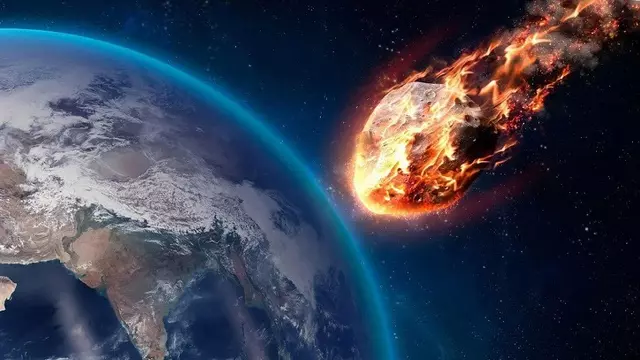Earth is set to experience two close encounters with massive asteroids, both larger than some of India’s most iconic landmarks, as they make their way through the cosmos. Classified as “potentially hazardous” due to their size and proximity, these asteroids will come within a safe but significant range of our planet on December 3 and 4, providing scientists a rare opportunity to observe these colossal celestial objects in detail.

The First Encounter: Asteroid 447755 (2007 JX2)
The first asteroid, named 447755 (2007 JX2), will make its closest approach to Earth on December 3 at 4:46 AM IST. Measuring between 300 and 670 meters in diameter, this massive object is larger than Delhi’s Jawaharlal Nehru Stadium. Traveling at a speed of approximately 44,000 km/h, the asteroid will come within 5.5 million kilometers of Earth’s orbit.
This distance, though significant in astronomical terms, poses no immediate threat to our planet. To provide context, the Moon orbits Earth at a much closer distance of 384,400 kilometers, making this encounter relatively safe.
The Second Close Call: Asteroid 2020 XR
Just a day later, on December 4 at 5:27 AM IST, a second asteroid named 2020 XR will pass by Earth. Slightly smaller than its predecessor, it spans between 290 and 650 meters, comparable in size to the Statue of Unity, the world’s tallest statue located in Gujarat, India.
Asteroid 2020 XR will come even closer than 447755, skimming past Earth at a distance of 2.4 million kilometers. Although this asteroid is classified as “potentially hazardous” due to its proximity, NASA has assured there is no risk of collision.
Why These Asteroids Are Significant?
The classification of these asteroids as “potentially hazardous” is based on their size and trajectory. While they pose no immediate threat, objects of this magnitude could cause catastrophic damage if they were ever to collide with Earth.
The close approach of such large asteroids provides an invaluable opportunity for scientists to study their characteristics, trajectories, and composition. Observing these objects helps improve our understanding of Near-Earth Objects (NEOs) and contributes to developing better planetary defense mechanisms.
Insights From NASA’s Asteroid Watch
NASA’s Asteroid Watch Dashboard, part of the Planetary Defense Coordination Office, continuously monitors objects that approach Earth. By tracking their paths and evaluating potential risks, scientists gather crucial data to refine their models and strategies for future encounters.
“Close encounters like these are invaluable for advancing our understanding of asteroid dynamics,” a NASA spokesperson stated. “Such data is crucial for refining planetary defense strategies and preparing for any potential threats from larger objects.”
Learning From Past Events
While these current encounters are harmless, history provides reminders of the potential dangers posed by asteroids. For example, the 2013 Chelyabinsk meteor incident in Russia saw a 20-meter-wide object explode in the atmosphere, releasing energy equivalent to 500 kilotons of TNT. The shockwave injured over 1,500 people and caused extensive damage to buildings.
These events underscore the importance of continued vigilance and preparedness. Even relatively small asteroids can have significant effects if they strike populated areas.
Rare Opportunities For Scientific Exploration
Asteroids of this magnitude only approach Earth once every few years, making these visits valuable not only for planetary defense but also for advancing our understanding of the solar system. By observing their size, speed, and rotation, scientists can better predict their behavior and improve strategies for mitigating potential threats.
Additionally, these encounters provide unique opportunities to study the composition of asteroids, which hold clues about the early solar system. Understanding their makeup can contribute to fields ranging from geology to space mining.
What Makes Asteroids Hazardous?
Asteroids are classified as “potentially hazardous” based on two criteria:
- Proximity to Earth:
Objects that come within 7.5 million kilometers of Earth’s orbit are closely monitored to assess potential risks. - Size:
Large asteroids, like the ones approaching this week, are capable of causing regional devastation if they impact Earth.
While neither asteroid poses a threat this time, their classification highlights the need for vigilance.
A Reminder To Protect Our Planet
The close approaches of asteroids 447755 and 2020 XR are a spectacle for skywatchers and a sobering reminder of the importance of planetary defense. With efforts like NASA’s DART (Double Asteroid Redirection Test) successfully demonstrating the ability to alter an asteroid’s trajectory, humanity is making strides in preparing for potential asteroid threats.
However, these encounters also emphasize the need for continued investment in asteroid detection technologies and international cooperation to ensure the safety of our planet.
Cosmic Spectacle And Scientific Advancement
For scientists, these close encounters are more than a celestial show—they’re opportunities to refine models, test technologies, and expand humanity’s understanding of the cosmos. For skywatchers, the passing of these asteroids offers a rare chance to witness the dynamic and ever-changing nature of the solar system.
As these two giants sail harmlessly past Earth, they remind us of the vastness of space and the delicate balance required to protect our planet from its potential threats.

